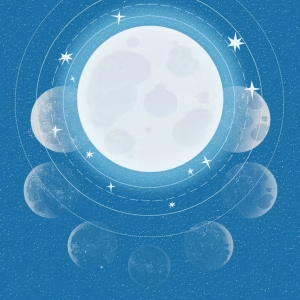
(Main image: Robert Lea (created with Canva))
This year, Earth will temporarily gain a second “moon” when a small asteroid will orbit our planet. This mini-moon will be visible starting in late September for about two months, until the end of November. It is a special phenomenon that occurs only occasionally, where an asteroid is caught by Earth's gravity and temporarily orbits our planet.
The asteroid, named 2024 PT5, was discovered in August by researchers at the ATLAS program (Asteroid Terrestrial-impact Last Alert System), which uses instruments in South Africa to monitor asteroids. Scientists from the Universidad Complutense de Madrid have studied the asteroid's orbit and determined that it will orbit Earth between Sept. 29 and Nov. 25.
What is a mini-moon?
A mini-moon occurs when an asteroid is temporarily held by Earth's gravity and orbits the planet. These objects usually remain in orbit for only a short time before they make their way back to the sun. There have been some mini-moons in the past, such as 2020 CD3 and 2022 NX1, both of which temporarily orbited the Earth before traveling further through the solar system. Scientists speak of a “gravitational capture” when objects such as 2024 PT5 be pulled into the earth's gravitational field.
What distinguishes these mini-moons from the fixed moon is that they do not make full revolutions around the Earth like our real moon. Like 2024 PT5, they linger for only a short time and often move in complex orbits, such as horseshoe-shaped trajectories, before being released and continuing their journey through space.
The orbit of 2024 PT5
The asteroid 2024 PT5, taken from the Arjuna asteroid belt, will move in a horseshoe-shaped orbit around our planet due to Earth's gravitational pull. This is because the asteroid negative geocentric energy has, meaning it remains within Earth's gravity. After 56 days, the asteroid will detach from Earth and return to its orbit around the sun. This mini-moon will not behave like a classic satellite orbiting the Earth, but rather like a “shop window viewer” that gets close to us without staying completely in a stable orbit.
The term “mini-moon” is often used to describe objects such as 2024 PT5 describe, but in fact they often follow a much more complex route. Instead of a perfect circular orbit, this object moves in a horseshoe shape and will never completely orbit the Earth. This makes the phenomenon of mini-moons unique and of particular interest to astronomers.
Scientific significance
The phenomenon of a mini-moon such as 2024 PT5 offers scientists the chance to better study the interactions between celestial bodies and the gravity of planets. Although these objects are usually relatively small and difficult to see, they help astronomers learn more about the dynamics of objects in our solar system. Carlos de la Fuente Marcos, professor at the Universidad Complutense de Madrid, explains that objects from the Arjuna asteroid belt are often located at small distances from Earth, with speeds as low as 3,540 mph. Under the right conditions, such as at 2024 PT5, they can be trapped by Earth's gravity and temporarily enter orbit.
Although 2024 PT5 is too small to see with the naked eye, binoculars or an ordinary telescope, the phenomenon does offer new insights for scientists. It helps to better understand the delicate balance between gravity, velocity and orbital mechanics.
Is the mini-moon visible?
Unfortunately 2024 PT5 are too small to see with the naked eye, binoculars or a standard telescope. Only with professional telescopes and specialized equipment astronomers will be able to track this mini-moon. It is an intriguing phenomenon for scientists and space enthusiasts, but for most people, the mini-moon will remain invisible. Even after it leaves Earth's orbit, the 2024 PT5 remain near our planet until January 2025 and then continue its journey.
While we may not be able to observe this mini-moon, the fact that an object is temporarily “captured” by Earth is a fascinating example of how dynamic our solar system is. It reminds us how complex the interactions between celestial bodies can be and how space objects are in constant motion. 2024 PT5 will reappear near Earth in 2055, meaning that we may witness such gravitational capture again in the future.
Conclusion
Although most people 2024 PT5 will not be able to see with their own eyes, it remains a remarkable phenomenon in astronomy. The temporary arrival of this mini-moon offers us another glimpse into the wonders of our solar system. While Earth retains its own faithful moon, the arrival of a mini-moon such as 2024 PT5 showing us how dynamic and changing the space around us is.
With this mini-moon, we get a brief but instructive reminder of the complexity and beauty of the universe, with small objects such as 2024 PT5 temporarily part of our planetary environment.






